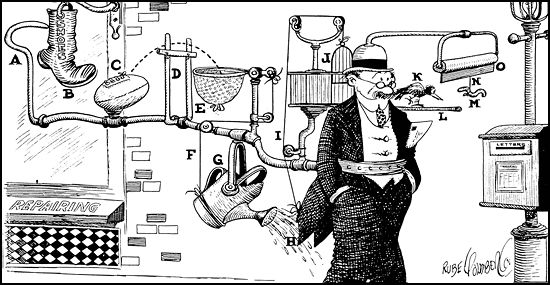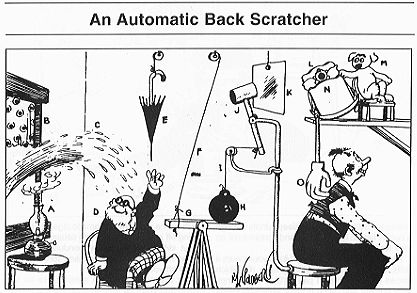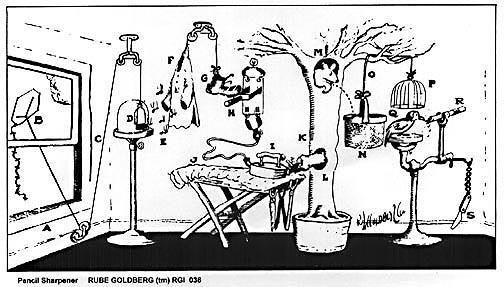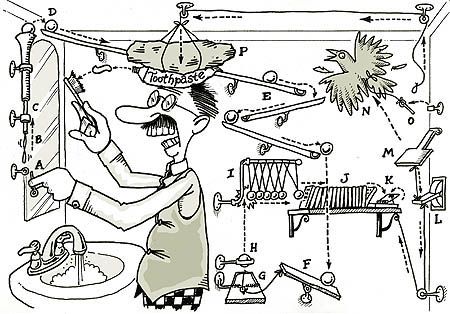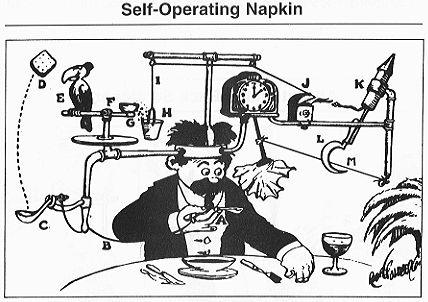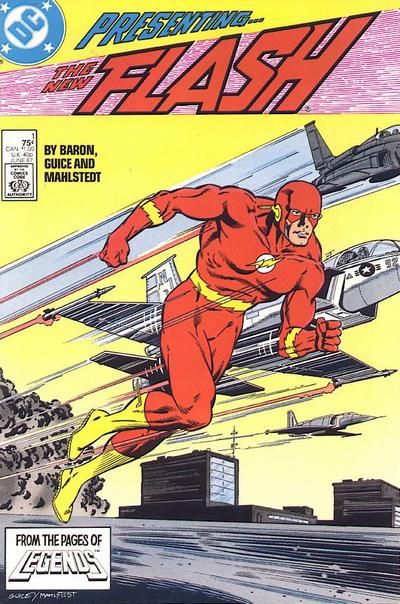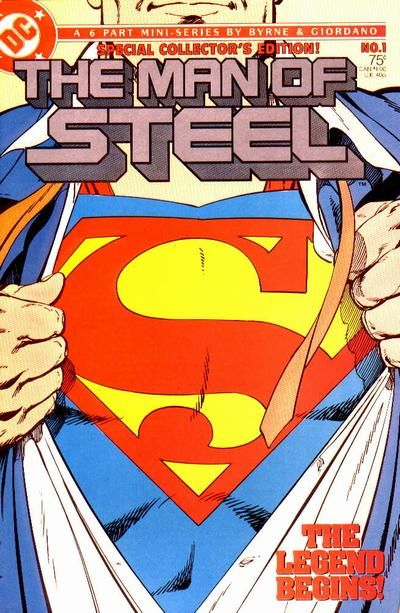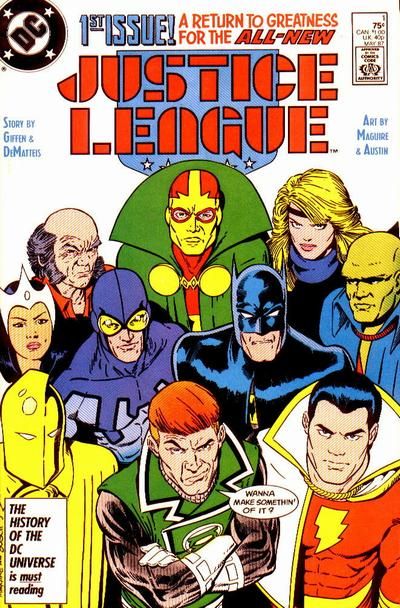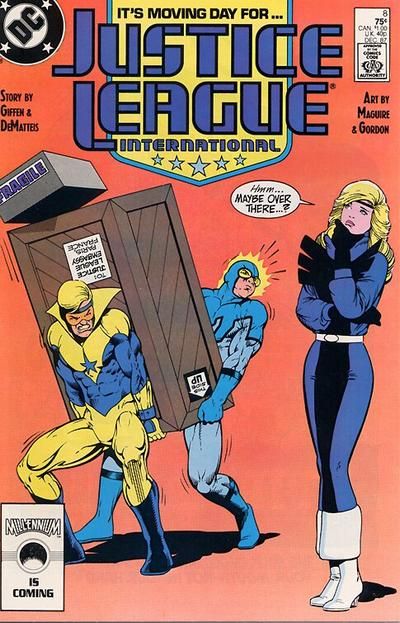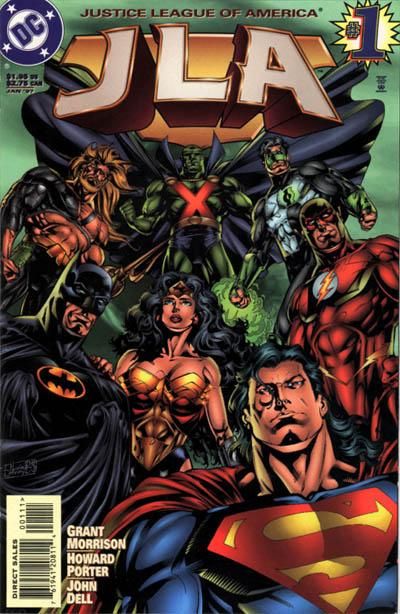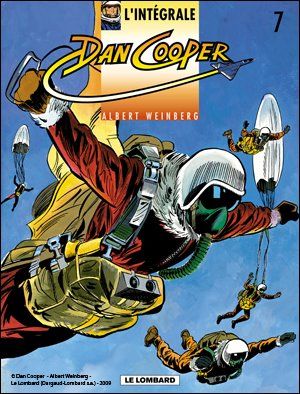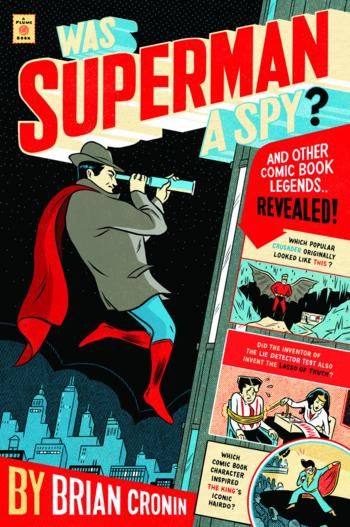This is the one-hundred and ninety-ninth in a series of examinations of comic book legends and whether they are true or false. Click here for an archive of the previous one-hundred and ninety-eight.
Let's begin!
COMIC LEGEND: Rube Goldberg was the first person to have his name listed as a definition in the dictionary while he was still alive.
STATUS: False
Reader Jeff Ryan asks:
I remember hearing that Rube Goldberg (who I just learned from you was an editorial cartoonist besides the zany-invention doodler) was the first person who had his name become a dictionary definition while he was still alive. (Mr. Bowdler and Mr. de Sade, among others, had to wait until they were dead before bowdlerize or sadistic made it in.)
Don't know which dictionary the legend refers to, or if they did Rube the solid of printing a picture of a "rube goldberg" device next to the definition.
Rube Goldberg is an interesting historical figure as far as cartooning goes, because while Goldberg was an extremely popular cartoonist for decades, nowadays (and likely the future, as well) he is not known for his actual work at all, but for a humorous type of machinery that even today still bears his name.
Goldberg, at his peak, was doing three or four different cartoon series at a time. One of these cartoon series was drawing different "inventions" that would help people in their everyday life, but would help them in the most convoluted and time-wasting manner possible.
Here are a few examples of classic "Rube Goldberg machines/devices/inventions"...
The film "Pee Wee's Big Adventure" has a notable scene early on with a Rube Goldberg device (it begins at the link below at about the 1:10 mark and goes on for about 2 and a half minutes)...
Starting in 1987, Purdue University has been having a yearly Rube Golberg Machine Contest, where college students enter their best overengineered devices.
Okay, so the term "Rube Goldberg Device/Invention/Machine/Whatever" is certainly one that is ingrained in the public consciousness.
But was it in the dictionary when Goldberg was still alive?
A quick check reveals that yes, "Rube Goldberg" was in the 1961 Webster's Third New International Dictionary, a full nine years before Goldberg died. The current Webster's definition for "Rube Goldberg" is "accomplishing by complex means what seemingly could be done simply."
So that part is correct (I can't say if they put a picture of a Rube Goldberg device in there with him, but that's neither here nor there).
But was Goldberg the first person to get this treatment while still alive?
As you might imagine, it's a bit of a pain to actually demonstrate WHEN words were put into the dictionary, but luckily, I was able to find out some of the new words added to Webster's Dictionary in the 1879 supplement to the 1864 edition (the first massive Webster's Dictionary).
Among the words added in 1879 were:
aggressively, alcoholism, bicycle, card-catalogue, carpet-bagger, Darwinian, derringer, dynamite, evolution, Gatling-gun, greenback, helio-type, hrupp-gun, lacrosse, microphone, nihilist, phenomenal,
phonograph, Pullman-car, type-writer.
Of these sampled words (of the 4,000 new words added in 1879), we see three words from the Proper names of actual people. And all three, Charles Darwin, Richard Gatling and George Pullman, were still alive in 1879 to see their names immortalized in the pages of Webster's Dictionary.
So, well, no, Goldberg was not the first.
Thanks to Jeff for the question and thanks to Stewart Steger for the Dictionary research!
COMIC LEGEND: The Giffen/DeMatteis Justice League run was originally envisioned to be a "Big Seven" series like Grant Morrison's JLA.
STATUS: True
Keith Giffen and J.M. DeMatteis' Justice League series (which began as Justice League before becoming Justice League International before splitting off into two titles, Justice League America and Justice League Europe) was one of DC's biggest hits of the late 1980s. In fact, for some time it was DC's highest-selling monthly title.
The book was known for its unique approach to superhero comics, where the book spotlighted humorous situations mostly, in a sort of situational comedy take on superheroes. Part of this approach was predicated on the fact that Giffen and DeMatteis had characters who were not being used by any other writers, so they had the freedom to do what they wanted with Blue Beetle, Booster Gold, Fire, Ice and, to a lesser extent, Guy Gardner and Martian Manhunter (not to mention their own creation, Maxwell Lord).
So with the great success the pair had on the title, you would think that this was their plan all along.
However, this was actually one of the greatest examples of making lemonade out of lemons that I can think of offhand.
When editor Andy Helfer was tasked by DC Editor-in-Chief Dick Giordano to come up with a new Justice League series to follow up the then-ending Justice League of America series, the idea was to do a complete 180 from what the Justice League had become at that point. A few years earlier, writer Gerry Conway attempted a bit of an "All-New, All-Different" Justice League, consisting of mostly young new characters with a few older (less famous) Justice League members. The group was headquartered in Detroit, and has since become a bit derisively referred to as "Justice League Detroit." The stories were fine, but the book did not go over too well, commercially.
So now Helfer was to come up with a brand-new Justice League book to launch out of the Legends cross-over (at the same time, a few other new series were launching, such as George Perez' Wonder Woman and Mike Baron's Flash, with John Byrne's Superman having just recently debuted).
This was going to be a bit of a "return to greatness." The biggest and best superheroes in the DC Universe all on one team together!
Only problem was, the aforementioned reboots? The writers and editors of those books didn't want their characters involved in the Justice League at that particular point in time.
So suddenly the "Big Seven" was missing Superman, Wonder Woman and the Flash.
Aquaman was in creative limbo at the time and HE was made off-limits, too.
So now the "Big Seven" was the "Big Three," and Helfer was lucky enough to have Denny O'Neil agree to let Batman be a part of the team. Martian Manhunter was a lock. That just left Hal Jordan, and since Helfer was editing Green Lantern, he could make that happen, but with the way things were shaking down, he figured that instead they would use the newer Green Lantern, Guy Gardner.
So then they just filled the rest of the book with as many middle-rung characters as they could, including characters with their own series (Booster Gold, Blue Beetle), new additions to the DC Universe (Captain Marvel, Dr. Light), old members of the League (Black Canary) and just fairly popular middle-of-the-road characters (Dr. Fate, Mister Miracle).
It was then that Helfer and Keith Giffen decided that with this cast, they were much better off trying a different approach than a standard superhero comic, because this cast was not likely to cut it as a standard superhero comic (especially when Captain Marvel, Dr. Fate, Dr. Light and Black Canary all soon became unavailable, too - even Batman eventually became unavailable).
So began the series that soon became DC's best-selling title (before the Batman movie, of course).
And it was almost a full decade before DC let anyone do "the best and the brightest" heroes in the Justice League, and that was good as well!
Thanks to Andy Helfer for being so upfront with the creation of the Justice League series over the years.
COMIC LEGEND: The FBI recently suggested that a comic book character may have been the inspiration for D.B. Cooper.
STATUS: True
The D.B. Cooper story is one of the great mysteries in American law enforcement history. As I'm sure you all have heard by now in one form or another (as the legend has made its way throughout popular culture - heck, it was just recently a plot point on Prison Break, for crying out loud!), in November 1974, somewhere between the South end of Washington and the North end of Oregon, a man parachuted out of a plane he’d just hijacked clutching a bag filled with $200,000 in stolen cash.
No one knows what happened to him after that and no one knows who he was BEFORE that.
It's a remarkable mystery (mostly because it is still a mystery!).
However, recently, of all places, the FBI themselves have posted on their website the possibility that D.B. Cooper was inspired by a comic book character!!
On the FBI's official site, the following was posted on Tuesday...
[A]s it turns out, a certain Dan Cooper is very much alive—on the pages of a French comic book series that was popular when the hijacking occurred. In the fictional series, Royal Canadian Air Force test pilot Dan Cooper takes part in adventures in outer space and real events of that era. In one episode, published near the date of the hijacking, the cover illustration shows him parachuting.
Seattle Special Agent Larry Carr, who took over the Cooper case two years ago, believes it’s possible the hijacker took his name from the comic book (the enduring “D.B.” was actually the result of a media mistake). That’s important because the books were never translated into English, which means the hijacker likely spent time overseas. This fits with Carr’s theory that Cooper had been in the Air Force.
Carr discovered the comic book connection on D.B. Cooper Internet forums, where fascination with the case is undiminished. The forums are also where Carr found the “citizen sleuths” who volunteered to help us reinvigorate the case.
Even though our investigation has remained open, it doesn’t make sense for the FBI to commit substantial resources to this nearly four-decade-old crime, Carr says. “So if the public can help, by whatever means, maybe we can shake something loose.”
It is interesting to note that the whole "D.B." part was part of erroneous reporting, and the "B" was never part of his name, he was always just "Dan Cooper."
As Robert Pincombe reports on his blog (click here to read his piece), it is most likely just a case of the FBI trying to drum up some news interest in the case to help them get people willing to help their investigation for free (and it seems to have worked, as a number of newspapers have picked up the story), but still, it's fascinating to see the FBI themselves making this suggestion!
Thanks to Robert for suggesting this story. Be sure to check out his blog, ComiCanuck, especially if you're interested in Canadian comic history.
Okay, that's it for this week!
Thanks to the Grand Comic Book Database for this week's covers!
Feel free (heck, I implore you!) to write in with your suggestions for future installments! My e-mail address is cronb01@aol.com.
As you know by now, Plume Books (a division of Penguin Books) is publishing a collection of my Comic Book Legends Revealed columns (half expanded "best of"/half new stuff) and it is due out on April 28th.
Here is the cover by artist Mickey Duzyj. I think he did a very nice job (click to enlarge)...
If you'd like to pre-order it, you can use the following code if you'd like to send me a bit of a referral fee...
Was Superman a Spy?: And Other Comic Book Legends Revealed
See you next week!

